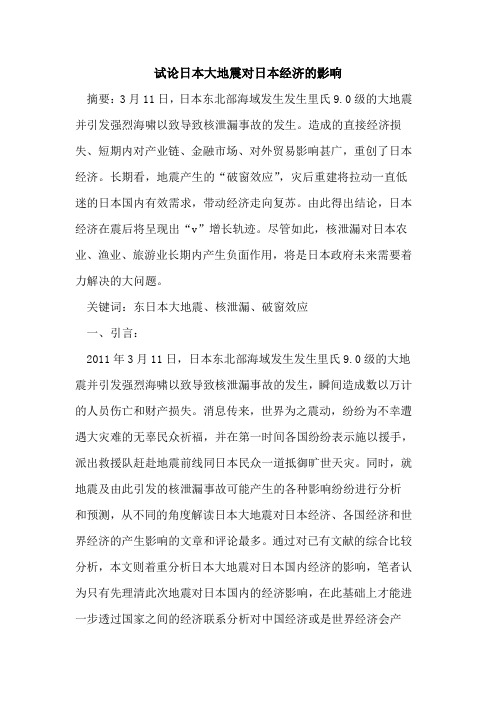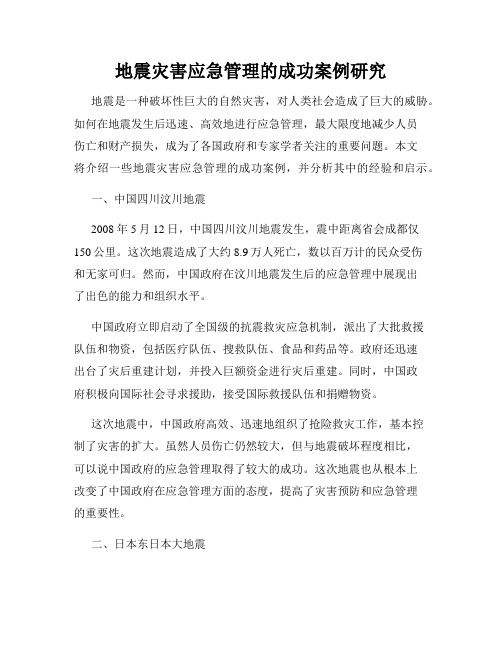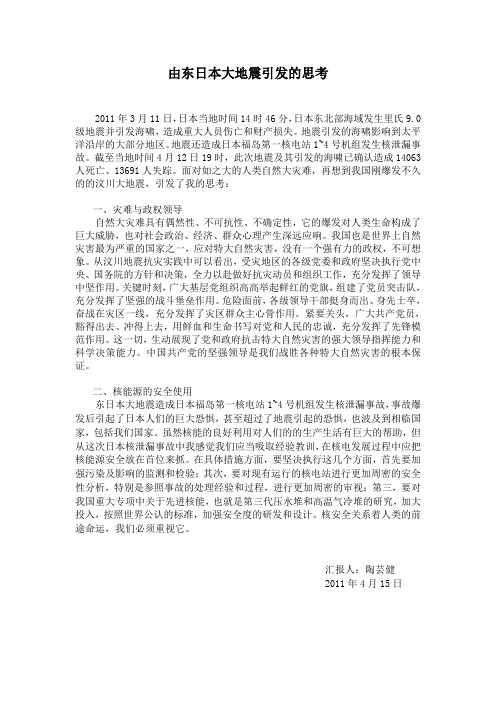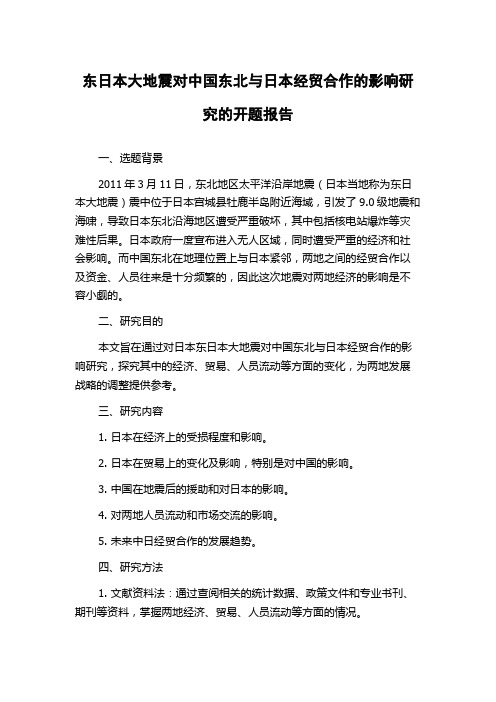2011年东日本大地震和海啸的调查和研究
日本大地震对日本经济影响

试论日本大地震对日本经济的影响摘要:3月11日,日本东北部海域发生发生里氏9.0级的大地震并引发强烈海啸以致导致核泄漏事故的发生。
造成的直接经济损失、短期内对产业链、金融市场、对外贸易影响甚广,重创了日本经济。
长期看,地震产生的“破窗效应”,灾后重建将拉动一直低迷的日本国内有效需求,带动经济走向复苏。
由此得出结论,日本经济在震后将呈现出“v”增长轨迹。
尽管如此,核泄漏对日本农业、渔业、旅游业长期内产生负面作用,将是日本政府未来需要着力解决的大问题。
关键词:东日本大地震、核泄漏、破窗效应一、引言:2011年3月11日,日本东北部海域发生发生里氏9.0级的大地震并引发强烈海啸以致导致核泄漏事故的发生,瞬间造成数以万计的人员伤亡和财产损失。
消息传来,世界为之震动,纷纷为不幸遭遇大灾难的无辜民众祈福,并在第一时间各国纷纷表示施以援手,派出救援队赶赴地震前线同日本民众一道抵御旷世天灾。
同时,就地震及由此引发的核泄漏事故可能产生的各种影响纷纷进行分析和预测,从不同的角度解读日本大地震对日本经济、各国经济和世界经济的产生影响的文章和评论最多。
通过对已有文献的综合比较分析,本文则着重分析日本大地震对日本国内经济的影响,笔者认为只有先理清此次地震对日本国内的经济影响,在此基础上才能进一步透过国家之间的经济联系分析对中国经济或是世界经济会产生哪些影响。
在讨论之前首先让我们回顾一下这次日本140年来最严重的地震,也是为我们后续的分析做必要的准备。
东日本大地震①发生在日本东北部距离仙台港以东130公里处太平洋海域。
地震发生后,对地震震级测定的报道不断刷新,由日本气象厅最初定级为7.9级,一路调至到8.8级,最后定级为9.0级。
并引发浪高最高达到23米的海啸,重创东北部地区。
截至目前,地震海啸已造成14133人死亡,13346人失踪,成为二战以来造成日本死亡人数最多的灾难。
大地震还导致日本福岛县第一核电站发生7级爆炸事故,大量放射性物质泄漏造成重大二次灾害,是日本迄今最为严重的核泄漏事故。
日本海啸灾害中的海洋污染与环境修复

日本海啸灾害中的海洋污染与环境修复海洋是地球上最宝贵的财富之一,然而,在自然灾害中,特别是海啸灾害中,海洋面临着巨大的破坏与污染。
本文将探讨日本海啸灾害中的海洋污染情况以及海洋环境修复措施。
一、日本海啸灾害中的海洋污染情况2011年3月11日,日本东北地区发生了一次严重的海啸灾害,被称为东日本大地震及其引发的海啸。
这场海啸不仅造成了人员伤亡和房屋倒塌,还对海洋生态系统造成了严重破坏。
一方面,海啸携带着大量的泥沙和废墟进入海洋,导致水域混浊,光线透射能力下降,影响了海底和浮游生物的生存环境。
另一方面,海啸还将大量的化学物质、石油及其他污染物带入海洋,造成了海洋污染的严重情况。
据统计,海啸引发的物质进入海洋中,造成了大面积的沿岸污染。
化学物质和石油等有害物质的释放使得海洋生态系统的平衡被打破,对许多水生生物构成了威胁。
同时,海洋污染还对渔业、海岛旅游等经济活动带来了巨大的负面影响。
二、海洋环境修复措施面对日本海啸灾害中的海洋污染问题,相关部门采取了一系列措施,旨在修复海洋环境,保护水生生物的生存空间。
1. 物理方法物理方法是海洋环境修复中常用的手段之一。
例如,通过使用吸油棉、围栏和隔离带来阻止污染物扩散,减少对更大范围海域的影响。
同时,利用过滤和沉淀等物理手段可以从海水中除去悬浮物和沉积物,恢复水质的清澈度。
2. 化学方法化学方法主要是利用吸附剂和沉淀剂来吸附和沉淀污染物质,以减少其在海洋环境中的浓度。
这些化学物质通常是有选择性地吸附有害物质,以确保修复过程中尽可能减少对海洋环境的影响。
3. 生物方法生物方法是利用生物资源来修复海洋环境的一种手段。
例如,引入某些植物和动物,利用其生物活性分解有害物质、吸收营养物质等功能,来促进海洋环境的修复。
此外,还可以通过海洋生物多样性的恢复来提高海洋生态系统的稳定性,以防止海洋污染的扩散和加剧。
4. 政策与管理除了上述修复措施外,政策和管理的角度也至关重要。
国家和地方政府应加强对海洋环境修复的监管和管理,确保修复工作得到有效执行。
日本海啸灾害的历史文献整理与分析

日本海啸灾害的历史文献整理与分析自古以来,日本位于环太平洋地震带,地震和海啸成为日本常见的自然灾害。
本文将对日本历史上发生的海啸灾害进行文献整理与分析,以便深入了解这些灾害的影响以及应对方法。
一、日本古代海啸灾害的记录在日本古代,由于科学技术的不发达,人们无法准确地预测地震和海啸的发生。
然而,许多古代文献中都记载了当时发生的海啸灾害。
例如,日本最古老的历史书籍《日本书纪》中记载了公元684年发生的齐鲁海啸,该灾害导致众多村庄被毁并造成大量人员伤亡。
此外,其他古代文献如《万叶集》、《古事记》和《绘本纪》等也都有所记载。
通过整理这些古代文献,我们可以了解到古代日本人对于海啸的描述,以及对海啸灾害的影响。
二、日本现代海啸灾害的实录随着科学技术的进步,现代日本能够更准确地观测和预测地震和海啸的发生。
因此,对于现代海啸灾害的记录更为详细和准确。
其中最著名的一次海啸灾害发生在2011年3月11日,被称为东日本大地震和福岛核事故。
这次地震引发了一系列强烈的海啸,造成沿东北海岸的许多城市和村庄被毁,并导致大量人员伤亡和福岛核电站事故。
通过当时的新闻报道、地震研究机构的报告以及幸存者的经历,我们可以更加全面地了解这次灾难的规模和影响。
三、日本海啸灾害的影响和教训历史上的海啸灾害给日本带来了巨大的伤害,但同时也让日本人认识到海啸的威力和教训。
在古代,人们尝试通过修建堤坝、建造高台等方式来防止海啸灾害的发生。
近代,以科学技术为基础的建筑技术和防灾措施得到了广泛应用,如建设高耐震度的建筑物、海岸防护设施的建设以及加强人员疏散和预警系统等。
例如,日本建设了特殊的防潮墙,以抵御可能发生的海啸灾害,并通过地震和海啸预警系统来迅速通知人们。
这些经验教训无疑可以为其他国家在面对海啸灾害时提供参考。
四、文献分析的问题与展望通过整理和分析海啸灾害的历史文献,我们可以深入了解日本古代和现代的海啸灾害。
然而,由于历史文献的限制以及古代观测方法的不准确性,部分文献可能存在一定的误差。
日本事件风险案例分析终稿

一、可以以各国财政预算缴纳一定比例的形式,建立永久性的全球 巨灾基金,使受害国在发生灾害后更好地提供迅速可靠的援助。 二、创立全球巨灾商业保险联合体,这样可以整合各国商业保险的 资源和资金实力。 三、加大巨灾风险信贷、债券、期权等多钟金融工具的使用。比如 巨灾债券就是一种场外交易的债权衍生物,是保险公司或者再保 险公司通过直接发行公司债券,利用债券市场来分散风险的风险 证券化形式,以实现保值增值。因此,巨灾融资渠道的拓宽不仅 使投资主体从政府援助、保险市场扩展到了资本市场,也有效实 现了风险的转移与分散。 四、建立巨灾保险的再保险体系,成立巨灾保险风险准备金等形式, 保证巨灾风险基金的后续资金投入。风险储备金可包括各参与国 的保费,多方捐赠信托基金用于运营支出之外的部分,储备金的 利息收入,储备金通过国际资本市场获得的资本利得等等。
谢谢观看!
三、事件风险损失的原因分析
• 关于地震:专家解释说,日本这次强震是由太平 洋板块在日本海沟俯冲入日本下方,并向西侵入 欧亚板块造成 ,即为大自然灾害。 • 关于海啸:专家认为,海啸规模如此之大原因有 二,一是地震本身规模大且震源浅,二是震源所 在海域海岸地形特殊,放大了海啸能量。 • 关于核电站:由于如此强的地震、海啸,整个核 电站的管道、设备、阀门、电器盘柜都受到了不 同程度的损伤,使得几乎所有的机组的冷却功能 都受到了损坏,甚至完全失效 。堆芯失去了冷却 功能,堆芯热量载不出来就造成严重的事故。
•
四、日本福岛核电站的核泄漏与核试验 的风险比较什么是核试验?
什么是核试验?
为了军事研究和科学研 究目的在预定条件下进行 的核爆炸装置或核武器爆 炸试验。
按试验时的环境条件不同,核试验的方式有: 大气层核试验、高空核试验、地下核试验和水下 核试验。核试验方式的选择与试验目的有关。 核试验其主要目的是:鉴定核装置的威力及其 他性能,验证理论计算和结构设计是否合理,为 改进核武器设计或定型生产提供依据;在核爆炸 环境下研究核爆炸现象学和各种杀伤破坏因素的 变化规律,研究核爆炸的和平利用等。它是一项 规模很大、需要多学科、多部门协同配合和耗费 大量人力、物力的科学试验 。
论文—日本地震原因及影响

论日本地震原因及其影响摘要:2011年3月11日,日本东北部宫城县以东太平洋海域发生里氏9.0级地震,强烈地震引起的巨大的海啸,日本遭受到前所未有的巨大的损失。
同时,地震与海啸还造成了福岛第一核电站发生核泄漏、放射性物质剧增、日本列岛部分沉没、火山爆发等严重后果,而且日本本身的经济也波动到全球,这是一次大型的海底板块相碰运动,我们人类只能想尽方法将伤害降低到最少。
本文基于此次地震灾害,会谈到日本地震的具体原因及其影响。
关键词:地震;板块运动;海啸;影响一、日本地震基本概况北京时间3月11日13时46分,日本本州东海岸附近海域发生的9.0级强烈地震,震源深度10公里,11-13日共发生168次5级以上余震,已确认14704人遇难 10969人失踪。
此次地震对日本的人民、经济带来了巨大的灾难。
同时,此次地震还引发了各种灾难,例如海啸、核电站发生核泄漏等。
二、地震发生的原因此次地震的震中海域位于太平洋海沟俯冲型地震带上,强震发生时引起海底破裂,产生数十米垂直位移量,从而引发巨大的海啸。
海底板块相碰引起地震和海啸,具体就是环太平洋板块与欧亚板块相碰撞,冲至欧亚板块下方。
依据美国国家航空航天局收集的资料,这次强震使日本本州岛向东移动大约3.6米,地轴移动25厘米,使地球自转加快1.6微秒,地轴移动6微米。
位于震中西北部的宫城县牡鹿半岛向震中所在的东南方向移动了约5.3米,同时下沉了约1.2米,这是日本有观测史以来最大的地壳变动记录。
而朝鲜半岛也东移5.16厘米;我国北方地区也出现几毫米的东移现象。
三、地震的影响地震无论从什么方面来看,经济、文化、政治、社会等,都对日本本国,甚至全世界都产生极大的影响,涉及面广,影响深远。
下面将对几个主要的影响进行阐述。
1、核泄漏核能外泄又称为核熔毁,是种发生于核能反应炉故障时,严重的后遗症。
核能外泄所发出的核能辐射虽远比核子武器威力与范围小,但是却相同能造成一定程度的生物伤亡。
日本海啸灾害的社会经济影响分析

日本海啸灾害的社会经济影响分析自古以来,海啸一直是沿海地区面临的重大自然灾害之一。
而在日本这个坐落于环太平洋地震带的国家,海啸灾害更是常见且具有巨大的破坏力。
本文将对日本海啸灾害的社会经济影响进行分析。
一、灾害造成的人员伤亡和社会破坏日本位于环太平洋地震带,经常受到地震和海啸的威胁。
特别是2011年3月11日发生的东日本大地震和海啸,给日本带来了巨大的破坏。
据统计,这场海啸导致1.8万人失踪或死亡,数百万人受到影响。
大量房屋建筑被毁,交通运输系统瘫痪,整个社会秩序出现短暂混乱。
二、灾后重建所需财力投入海啸灾害往往导致大量房屋建筑、基础设施、农田和渔业设施的破坏,重建工作需要大量财力投入。
根据日本政府的统计数据,2011年东日本大地震和海啸导致的灾害损失高达25万亿日元,使得日本陷入了严重的财政困境。
三、海啸对渔业和农业的影响日本是一个以渔业和农业为主要经济支柱的国家,而海啸带来的洪水和淡水污染往往对这两个行业造成巨大影响。
海啸将水产养殖设施冲垮,引起海产物种大量死亡,给渔业带来重大损失。
同时,因为淡水源受到海水倒灌的影响,整个农作物种植区域也遭受严重破坏,导致农业产量下降。
四、旅游业受到冲击日本的旅游业一直是国民经济的重要组成部分。
然而,海啸灾害对旅游业造成了严重冲击。
海岸线上的景点和度假地成为海啸的主要破坏目标,游客的到来大幅减少,旅游业收入锐减。
除此之外,海啸灾害也破坏了旅游相关的基础设施,例如酒店、机场、交通网络等,恢复旅游业的发展需要大量时间和财力。
五、对基础设施的破坏和影响海啸以其巨大的能量和冲击力,常常摧毁沿海地区的基础设施。
例如,东日本大地震和海啸导致了重要的交通运输枢纽被严重破坏,影响了商品的流通和运输效率。
同时,大量房屋倒塌,给灾区居民的生活带来了重大困扰。
六、对环境的影响海啸不仅对人们的生命和财产造成威胁,还对环境造成了负面影响。
海啸携带大量的泥沙、淡水、化工废料等物质进入海洋,导致海洋污染和生态破坏。
日本地震对自然地理的影响

日本地震对自然地理的影响作者:梁东成来源:《地理教育》2011年第11期北京时间2011年3月11日13时46分(当地时间14时46分),日本发生9,0级大地震,震中位于宫城县以东太平洋海域(38.1°N,142.6°E),震源深度约20千米,东京有强烈震感。
这次地震是1900年以来的第四强震,也是日本自130年前有现代仪器记录以来的最大地震。
日本大地震引发的海啸、核泄漏事件,造成重大人员伤亡和财产损失,并对地理环境、日本经济及全球经济产生了重大影响,以下是从自然地理角度分析日本地震产生的影响。
1.促使地球自转运动加快这次日本里氏9.0级地震非常猛烈,它导致地球自转轴发生25厘米位移,而地轴移动可改变地球自转速度,从而改变一天的时间长短。
日本大地震导致当天地球的自转时间减少了1.8微秒,即地球自转速度每天加快1.8微秒(1微秒等于一百万分之一秒)。
这是因为日本大地震造成大范围的地壳板块位移,改变了地球的整体质量分布,进而影响到地球自转。
就像花样滑冰运动员用脚尖旋转时会不由自主地摆臂一样,当全球质量分布发生改变时,地球的自转速度也会发生变化。
在地震中,地球质量的分布越向赤道地区集中,地球就会转得越快。
2.导致地壳板块平移及地面沉降日本是地震频繁发生的地带。
日本群岛正好位于亚欧板块和太平洋板块交界处,在亚欧板块与太平洋板块碰撞、挤压之下,交界处的岩层便出现变形、断裂等运动,容易产生地震与火山爆发现象。
这次日本大地震使海底地壳出现长约400千米、宽约160千米的裂缝,并使日本本土东移2.4米,朝鲜半岛东移幅度最多超过5厘米。
当然,这个变化非常微小,在未来长达数个世纪里都不会被人类觉察到。
此次9.0级地震和大海啸还导致日本部分地区海拔下降,使日本东北部由北向南大约443千米2的陆地被海水吞没,总面积超过东京的七成。
这次强烈地震是岩石圈在内力作用下突然发生破裂,地球内能以地震波的形式强烈释放出来,是地壳运动的一种表现形式,其释放的能量成为营造地表形态的力量,从而影响日本沿岸地表形态变化,使部分地面发生沉降。
浅析日本地震

浅析日本地震张亚芳管理学院公共事业管理专业二班2011年3月11日14时46分左右,日本东北地区宫城县北部发生里氏9.0级特大地震,这是日本20多年来遇到的震级最高的地震,也是人类迄今为止遇到的少数震级如此之高的地震,更匪夷所思的是,伴随着地震而来的是人类最为恐惧的海啸和核辐射,霎那间,全世界人民都陷入了前所未有的恐慌中,自己的安全能否得到保证,是否世界末日即将到来,所有的不安,无奈,恐惧,都让人们化身成一个个学士或者说是战士,人们开始深入探讨日本地震的内幕,下面我就自己对日本地震的了解,简单的抒发个人的见解。
日本地震发生的原因当日本地震爆发后,美国发面给出了日本地震的解释,美国地质勘探局认为,此次发生在日本东海岸的东北关东大地震是有太平洋板块和北美板块的运动所致。
美国的一言一行必定要为美国的形象考虑,即使美国认识到了事件发生的真实原因,也不会随意说出,因为美国不允许日本有核武器,一旦日本有核武器,美国将对日本的占领宣告失败,所以美国只能找些客观的理由向世界发布,已找回自己的面子。
然而,从多发面综合分析,可以看出这可能完全是一场人为的大灾难即是人祸。
可能是日本自己进行的海底核试验引起的!理由如下:一、石原慎太郎前阵子刚刚放言要以核武器对抗中国,3月9日日本就发生了7.4级的地震。
这可以推论为石原的狂言只是为日本的核试验放言,而九日的地震其实就是日本进行的核试验。
如果不出意外,日本近期还将进行几次核试验,并在不久后在美国的默许下宣布为有核国家以对抗中国。
可惜,人算不如天算,想不到引发了世纪大地震而自食其恶果。
二、3月11日地震后,海面出现的神秘大漩涡,可能就是日本通向海底核试验场的隧道崩塌,导致海水倒灌引起的。
三、以日本现有的技术,能导致日本用于启动冷却设备的三道保障电网都出现故障,特别是柴油发电机不能发电,这有点不可思议。
合理的解释就是日本故意让电站爆炸让让核外泄,以便掩盖3月9日进行核试验发生的核辐射。
IAEA专家组对福岛核事故的调查报告

IAEA专家组对福岛核事故的调查报告针对日本东部大地震和海啸引发的福岛第一核电站核事故调查报告目录总结41、介绍101.1 背景 101.2 调查目的161.3 调查范畴161.4 调查的开展 172、导致福岛第一核电站的事故序列182.1 福岛第一核电站182.2 福岛第二核电站252.3 东海核电站 253、要紧成果、结论和体会教训263.1 引言 263.2 背景 263.3 国际原子能机构差不多原则:总述283.3.1 差不多安全原则3:核安全的领导和治理 29 3.3.2 差不多原则8:事故预防293.3.2.1 自然外部事件293.3.2.2 严峻事故313.3.3 差不多原则9:应急预备和响应333.3.3.1 场外应急预备以爱护公众和环境 333.3.3.2 场内应急打算以爱护工作人员353.4 国际原子能机构安全标准 363.5 国际原子能机构安全活动 363.4.1 复原路线图363.4.2 外部危机373.4.3 场外应急响应373.4.4 严峻事故情形下的大规模辐射防护组织373.4.5 后续IRRS审查384、致谢39总结2011年3月11日,日本东部发生9级大地震,地震引发一系列庞大海啸,突击了日本东部沿海。
最大浪高是在宫古岛的姉吉,达到38.9米。
地震和海啸给日本大片地区造成打击,15391人死亡,此外还有8171人下落不明。
大部分人口流离失所,他们生活的村镇被破坏或夷为平地。
许多基础设施也由于这次侵袭而瘫痪。
除了工业之外,许多核电站设施也由于严峻的地振动和大范畴的海啸而受到阻碍,包括东海、东通、女川、以及东电公司的福岛第一和第二核电站。
这些核电站在设计上都安装有自动停堆系统,在检测到地震时实现了机组成功停堆。
然而,庞大的海啸对这些核设施造成不同程度的阻碍,并导致东电公司的福岛第一核电站发生严峻事故。
尽管地震发生时,所有的厂外供电都差不多丧失,但东电公司福岛第一核电站的自动系统在检测到地震时成功地将所有操纵棒插入三个正在运行的反应堆,所有可用的应急柴油发电机也按设计处于运转状态。
日本海啸灾害的社会经济成本评估

日本海啸灾害的社会经济成本评估近年来,日本频繁遭受海啸灾害的袭击,这些可怕的自然灾害给该国的社会经济造成了巨大的损失。
本文将对日本海啸灾害的社会经济成本进行评估,并探讨灾后重建和预防措施对经济的影响。
一、灾害造成的直接经济损失首先我们来看一下日本海啸灾害造成的直接经济损失。
根据统计数据显示,由于海啸引起的房屋倒塌、基础设施受损以及农田被淹等原因,海啸灾害给日本经济造成了庞大的损失。
据估计,2011年东日本大地震和海啸灾害损失总额高达360亿美元。
这些直接经济损失主要包括重建成本、财产损失和生命财产保险索赔等。
其次,日本海啸灾害还带来了生产力的严重减退。
由于灾后的重建工作需要大量的时间和资源,许多企业的生产活动受到了严重影响。
许多企业的生产设施被毁,无法正常运转,这导致了大量的产能损失和生产中断。
此外,海啸灾害还对港口和物流基础设施造成了破坏,使得货物的进出口受到限制,进一步损害了日本的经济。
二、灾后重建的经济投入灾后重建是日本面临海啸灾害之后必须面对的一项重要任务。
为了恢复受灾地区的生活和经济,政府要投入大量的资金用于重建工作。
这些资金主要用于修复受损的基础设施、重建倒塌的房屋以及改善社区的设施和服务。
根据数据显示,日本政府在灾后重建方面的投入规模庞大,仅2011年一年,投入金额就超过300亿美元。
然而,灾后重建所需的巨大资金投入对于国家的财政状况产生了压力。
政府需要借债或者调整预算以满足重建所需的资金需求。
这将导致国家债务的增加或者其他领域的预算削减,对整个经济产生不利影响。
三、经济复苏和预防措施的影响海啸灾害不仅对经济造成了直接的损失,也对经济的复苏产生了一定的压力。
受灾地区的居民和企业需要一定时间来恢复生活和经营。
此外,由于灾后的环境恶化以及社会心理的影响,人们的消费意愿和投资意愿也会受到不同程度的影响。
为了减少日本未来可能面临的海啸灾害带来的损失,政府还采取了一系列的预防措施。
这些预防措施包括修建海防堤坝、提高建筑物的抗震能力、加强海啸预警系统等。
地震灾害应急管理的成功案例研究

地震灾害应急管理的成功案例研究地震是一种破坏性巨大的自然灾害,对人类社会造成了巨大的威胁。
如何在地震发生后迅速、高效地进行应急管理,最大限度地减少人员伤亡和财产损失,成为了各国政府和专家学者关注的重要问题。
本文将介绍一些地震灾害应急管理的成功案例,并分析其中的经验和启示。
一、中国四川汶川地震2008年5月12日,中国四川汶川地震发生,震中距离省会成都仅150公里。
这次地震造成了大约8.9万人死亡,数以百万计的民众受伤和无家可归。
然而,中国政府在汶川地震发生后的应急管理中展现出了出色的能力和组织水平。
中国政府立即启动了全国级的抗震救灾应急机制,派出了大批救援队伍和物资,包括医疗队伍、搜救队伍、食品和药品等。
政府还迅速出台了灾后重建计划,并投入巨额资金进行灾后重建。
同时,中国政府积极向国际社会寻求援助,接受国际救援队伍和捐赠物资。
这次地震中,中国政府高效、迅速地组织了抢险救灾工作,基本控制了灾害的扩大。
虽然人员伤亡仍然较大,但与地震破坏程度相比,可以说中国政府的应急管理取得了较大的成功。
这次地震也从根本上改变了中国政府在应急管理方面的态度,提高了灾害预防和应急管理的重要性。
二、日本东日本大地震2011年3月11日,日本东部发生了一次里氏9.0级的巨大地震,引发了海啸和核事故。
这次地震和海啸造成了超过1.5万人死亡,造成了巨大的人员伤亡和财产损失。
然而,日本政府通过其丰富的应急管理经验,展现出了出色的灾后恢复和重建能力。
日本政府在地震发生后立即启动了国家紧急状态,组织了大规模的救援行动。
政府及时向受灾地区提供了医疗救助、食品和水资源等物资援助。
此外,日本政府还实施了紧急疏散计划,将受威胁地区的民众转移到安全地带。
此外,政府还积极向国际社会寻求援助,并接受了来自各国的救援队伍和物资。
在灾后恢复和重建方面,日本政府采取了一系列措施。
政府制定了详细的重建计划和措施,并设立专门的机构负责重建工作。
政府还提供了资金援助和税收减免等措施,鼓励民众参与重建,并尽快恢复经济发展。
日本9级特大地震简介(徐锡伟 )

日本9级特大地震简介徐锡伟中国地震局地质研究所2011年3月11日日本东北部海域9级特大型地震,地震持续时间达5分钟,诱发了超过10米高的海啸,不仅冲刷了日本东北部海岸建构筑物、船只、汽车等所有地面物品,还引起了火灾、核电站设施爆炸、核泄漏和上万人死亡,这不仅仅是日本的灾难,也是全人类共同面对的灾难,引发了全球对核电站安全的担忧。
同时,还给我们带来了许多经验和教训,如果我们能够从中吸收有用的养分,有可能让我们今后更从容面对未来的地震灾害。
1地震基本参数时间:2011年3月11日14时46分23秒(东京时间)地点:日本本州东部海岸附近海域,北纬38.322,东经142.369震中:日本东北地区宫城县地震矩释放量:3.6×1022Nm,Mw=9.09级地震发生在太平洋板块俯冲到北美板块及更西的欧亚板块之下的巨型逆断层上(上图显示日本地震震源百年复发间隔的发震概率图:2011年地震发生在太平洋板块向西俯冲的板块边界带上(蓝色矩形框内,是原来预测的多个小于8级潜在震源a, B1, B2, b, c, d,and e级联破裂的结果)震源深度:24.4km震源机制解见下图:根据主震和余震和已有地震的准确定位资料和震源机制解等,可以推测发震断层:太平洋板块向西俯冲到北美板块及更西的欧亚板块之下的巨型低角度逆断层,属板块边界带地震。
发震断层走向:194.9度,倾向西,倾角14.9度。
用于约束板块俯冲带几何结构的地震分布图(据/earthquakes/eqarchives/subduction_zone/usc0001xgp/)板块俯冲带发震断层倾角拟合(据/earthquakes/eqarchives/subduction_zone/usc0001xgp/)板块俯冲剖面模型图(右侧为太平洋板块,下插到西侧北美板块(左侧)之下引发东北部海域9级特大地震破裂范围:南北长450km,东西宽150km破裂速度: 2.0km/s破裂持续时间:300 S,比汶川地震多3分钟最大断层滑移量:18m(据日本国立地球科学与防灾研究所资料)日本东北部海域9级特大地震震源破裂分布图(据日本国立地球科学与防灾研究所资料)GPS观测到的同震位移场:38.5度附近最大东南向位移7m(据名古屋大学Takeo Ito等,2011)。
日本海啸灾害中的伤亡原因与死亡统计

日本海啸灾害中的伤亡原因与死亡统计日本是一个位于环太平洋地震带上的国家,常年面临来自大海的威胁。
海啸是一种由地震、海底火山喷发、滑坡等引起的海洋潮汐,给日本带来了巨大的灾难。
在历史上,日本曾经多次经历过可怕的海啸灾害,其中最为人所熟知的是2011年的东日本大地震引发的海啸。
本文将探讨日本海啸灾害中的伤亡原因与死亡统计。
一、地震引起的海啸地震是引发海啸的最主要原因之一。
而日本位于火山地震带上,几乎每年都会发生多次地震。
地震引发的海啸具有凶猛的力量,可在短时间内将沿岸地区毁于一旦。
在2011年的东日本大地震中,强烈的地震引发了海底的构造破裂,巨大的能量释放导致了海啸的形成,给日本沿海地区带来了严重的破坏和伤亡。
二、海底火山喷发引发的海啸日本周边的环太平洋地区还存在许多火山岛,其中一些是活跃的火山。
火山喷发会导致海底地形的改变,进而引发海啸。
2011年的东日本大地震中,火山喷发导致了海底地形的剧变,进而引发了规模巨大的海啸,给沿海地区带来了重大的损失。
三、滑坡引发的海啸滑坡是另一种可能引发海啸的因素。
当悬崖、山坡等陡峭地形发生滑坡时,将海水推入海洋深处,形成潮汐,从而引发海啸。
滑坡引发的海啸可谓突如其来,威力惊人,给人们造成无法预测和应对的灾害。
四、海啸灾害的死亡统计根据统计数据,日本自20世纪以来经历了多次重大的海啸灾害,造成了大量人员伤亡。
2011年的东日本大地震与海啸灾害是最为致命的一次,据官方统计,死亡人数超过1.5万人,数十万人流离失所。
这场灾难给整个国家造成了巨大的破坏。
在海啸灾害中,死亡人数众多的原因主要包括以下几个方面:1. 海啸来袭速度快:海啸的速度可达数十公里每小时,给人们逃生造成了巨大的困难,导致很多人无法及时离开危险区域。
2. 渡海工具不足:日本是一个岛国,许多地区的交通主要依赖于海运工具,但在海啸来袭时,这些渡海工具往往被破坏或被卷走,给人们的逃生带来了很大困难。
3. 沿海地区人口密集:由于地理条件的限制,日本沿海地区的居民数量通常很大,而这些地区也是海啸灾害波及最严重的地方。
日本大地震

汶川地震
2008年 2008年5月12日14时28分04秒,四川汶川、 12日14时28分04秒 四川汶川 汶川、 北川, 强震猝然袭来 大地颤抖, 猝然袭来, 北川,8级强震猝然袭来,大地颤抖,山河 移位,满目疮痍,生离死别……西南处 西南处, 移位,满目疮痍,生离死别……西南处, 国有殇。这是新中国成立以来破坏性最强、 国有殇。这是新中国成立以来破坏性最强、 波及范围最大的一次地震 地震。 波及范围最大的一次地震。此次地震重创 50万平方公里的中国大地 万平方公里的中国大地! 约50万平方公里的中国大地!为表达全国各 族人民对四川汶川大地震 汶川大地震遇难同胞的深切 族人民对四川汶川大地震遇难同胞的深切 哀悼,国务院决定 2008年 决定, 19日至 日至21 哀悼,国务院决定,2008年5月19日至21 日为全国哀悼日 全国哀悼日。 2009年起 每年5 年起, 日为全国哀悼日。自2009年起,每年5月12 全国防灾减灾日。 日为全国防灾减灾日 日为全国防灾减灾日。
唐山大地震
唐山地震 1976年 1976年7月28日,在河北省唐山、丰南一带发生了7.8级强 28日 在河北省唐山、丰南一带发生了7.8级强 烈地震,这是我国历史上一次罕见的城市地震灾害, 烈地震,这是我国历史上一次罕见的城市地震灾害,北京 和天津市受到严重波及,地震破坏范围超过3 和天津市受到严重波及,地震破坏范围超过3万平方公里, 有感范围广达14个省、市、自治区,相当于全国面积的三 有感范围广达14个省、市、自治区,相当于全国面积的三 分之一,这次地震的震中位于唐山市区。即北纬39.6度, 分之一,这次地震的震中位于唐山市区。即北纬39.6度, 东经 118.2度,震中烈度为XI度,震源深度为11公里。极 118.2度,震中烈度为XI度,震源深度为11公里。极 震区内几乎所有建筑物均荡然无存,在震区及周围地区, 出现大量的裂缝带,喷水冒沙、井喷、重力崩塌,滚石、 边坡崩塌,地基沉陷,岩溶洞陷落以及采空区坍塌等。唐 山地震造成24.2万人死亡,16.4万人受重伤,仅唐山市区 山地震造成24.2万人死亡,16.4万人受重伤,仅唐山市区 终身残废者达1700多人,倒塌民房530万间。唐山地区总 终身残废者达1700多人,倒塌民房530万间。唐山地区总 的直接经济损失达54亿元,公共设施遭受严重破坏,灾情 的直接经济损失达54亿元,公共设施遭受严重破坏,灾情 之大举世罕见。
日本2011年海啸--来自观测结果和数值模拟的波传播特性

1 前 言
在2 0 1 1年 3月 1 1日的 5 : 4 6( UT C时 间 ) ,日本 的本 州 岛东海岸 发生 了 9 . 1 级 的大 型 俯冲 挤压地 震 ,震 源深度 为海底 3 2 k m,地震 以及 地震 形成 的海 啸 导致 日本 2 0 0 0 0人死 亡, 造 成广泛 而持久 的破坏 。 这次 地震 是近 6 0年发 生 的六 大地 震之一 ( 1 9 5 2 —2 0 1 1 年) , 这六 次大地 震所 释放 的能量 占该时 期地震 总 能量 的一半 。 另外五个 地震 分别为 1 9 5 2年堪 察加 半 岛的 9 . 0级地震 、1 9 6 0年智 利 的 9 . 5级地 震 、1 9 6 4年 阿拉 斯加州 的 9 . 4级地 震 、 2 0 0 4年苏 门答 腊 岛的 9 . 3级地 震和 2 0 1 0年智利 的 8 . 8 级 地震 。 在过 去 的十 年 中,现代海 平面 观测 网络技 术 明显改善 ,可 以对海 啸波传 播 、转换和
决定 了海啸的长期近平衡状态:在海 啸的波前通过 以后,海啸波 的能量密度和水深之间趋于反
比关 系 。因此 ,海 啸 波 强 度 可 以 简单 定 义 为 能 量 密度 乘 以水 深 。除 了南 冰 洋 和 白令海 的能 汇 区
外 ,海啸波强度均匀地覆盖了太平洋盆地 。
关键 词 :海啸 ;数值 模型 :测 高;波散 射 ;波 能 ;均分 定律
在 本 次研 究 中 ,我们 利 用 固定 仪器 和 卫 星测 高 的观 测 结果 来校 正 数值 模 型 ,研 究
2 0 1 1 年 日本海 啸波传 播 以及波场 时空转 换 。 太 平洋 形成 的海 啸波 除 了一 部分泄 漏到 陆缘
海 和其 它的海盆 ( 通过 南极 洲 、澳洲 和南美 洲 的海 峡 ) ,大多数 限制在太 平洋 。因此 可 以 研 究海 啸波在封 闭盆地 的传播 、反 射 、散 射 以及能量耗 散等物 理过 程 。
由东日本大地震引发的思考

由东日本大地震引发的思考2011年3月11日,日本当地时间14时46分,日本东北部海域发生里氏9.0级地震并引发海啸,造成重大人员伤亡和财产损失。
地震引发的海啸影响到太平洋沿岸的大部分地区。
地震还造成日本福岛第一核电站1~4号机组发生核泄漏事故。
截至当地时间4月12日19时,此次地震及其引发的海啸已确认造成14063人死亡、13691人失踪。
面对如之大的人类自然大灾难,再想到我国刚爆发不久的的汶川大地震,引发了我的思考:一、灾难与政权领导自然大灾难具有偶然性、不可抗性、不确定性,它的爆发对人类生命构成了巨大威胁,也对社会政治、经济、群众心理产生深远应响。
我国也是世界上自然灾害最为严重的国家之一,应对特大自然灾害,没有一个强有力的政权,不可想象。
从汶川地震抗灾实践中可以看出,受灾地区的各级党委和政府坚决执行党中央、国务院的方针和决策,全力以赴做好抗灾动员和组织工作,充分发挥了领导中坚作用。
关键时刻,广大基层党组织高高举起鲜红的党旗,组建了党员突击队,充分发挥了坚强的战斗堡垒作用。
危险面前,各级领导干部挺身而出、身先士卒,奋战在灾区一线,充分发挥了灾区群众主心骨作用。
紧要关头,广大共产党员,豁得出去、冲得上去,用鲜血和生命书写对党和人民的忠诚,充分发挥了先锋模范作用。
这一切,生动展现了党和政府抗击特大自然灾害的强大领导指挥能力和科学决策能力。
中国共产党的坚强领导是我们战胜各种特大自然灾害的根本保证。
二、核能源的安全使用东日本大地震造成日本福岛第一核电站1~4号机组发生核泄漏事故,事故爆发后引起了日本人们的巨大恐惧,甚至超过了地震引起的恐惧,也波及到相临国家,包括我们国家。
虽然核能的良好利用对人们的的生产生活有巨大的帮助,但从这次日本核泄漏事故中我感觉我们应当吸取经验教训,在核电发展过程中应把核能源安全放在首位来抓。
在具体措施方面,要坚决执行这几个方面,首先要加强污染及影响的监测和检验;其次,要对现有运行的核电站进行更加周密的安全性分析,特别是参照事故的处理经验和过程,进行更加周密的审视;第三,要对我国重大专项中关于先进核能,也就是第三代压水堆和高温气冷堆的研究,加大投入,按照世界公认的标准,加强安全度的研发和设计。
日本地震海啸资料

3·11日本本州岛海域地震百科名片震中位于宫城县以东太平洋海域2011年3月11日,日本气象厅表示,日本于当地时间11日14时46分发生里氏8.9级地震,震中位于宫城县以东太平洋海域,震源深度20公里。
东京有强烈震感。
美国地质勘探局将日本当天发生的地震震级从里氏8.9级修正为里氏8.8级。
北京小部分区域有震感,对中国大陆不会有明显影响。
不过,此次地震可能引发的海啸将影响太平洋大部分地区。
北京时间3月13日,日本气象厅再次将震级修改为9.0级。
目录灾情简介震级修正人员伤亡3月12日3月13日3月14日3月15日3月16日3月17日海啸警报救灾活动二次灾害具体影响日本美国全球经济冲击日本地震影响全球产业链背景资料震区景象地震引发海面上出现大漩涡燃气泄漏火灾频现日史上最大级别地震多处停电,炼铁厂发生爆炸东京塔塔顶出现歪斜通信网络中断救援情况自卫队军舰和战机参与搜救中国表示愿派救援队福岛第一核电站2号机组泄漏余震信息日本天皇呼吁灾情简介震级修正人员伤亡3月12日3月13日3月14日3月15日3月16日3月17日海啸警报救灾活动二次灾害具体影响日本美国全球经济冲击日本地震影响全球产业链背景资料震区景象地震引发海面上出现大漩涡燃气泄漏火灾频现日史上最大级别地震多处停电,炼铁厂发生爆炸东京塔塔顶出现歪斜通信网络中断救援情况自卫队军舰和战机参与搜救中国表示愿派救援队福岛第一核电站2号机组泄漏余震信息日本天皇呼吁展开编辑本段灾情简介2011年3月11日14时46分(北京时间13时46分)发生在日本本州东海岸附近海域的里氏9.0级地震,震中位于北纬38.1度,东经142.6度,震源深度约20公里。
日本气象厅随即发布了海啸警报,称地震将引发约6米高海啸,后修正为10米。
北京小部分区域有震感,但对中国大陆不会有明显影响。
不过,此次地震可能引发的海啸将影响太平洋大部分地区,但对中国大陆不会有明显影响。
据权威人士表示,由于此次地震发生在日本东北部,距离中国大陆比较远,且中国大陆架性质决定了在这段距离中有一片相对较浅的海域,所以对大陆不会有明显影响。
东日本大地震对中国东北与日本经贸合作的影响研究的开题报告

东日本大地震对中国东北与日本经贸合作的影响研
究的开题报告
一、选题背景
2011年3月11日,东北地区太平洋沿岸地震(日本当地称为东日本大地震)震中位于日本宫城县牡鹿半岛附近海域,引发了9.0级地震和海啸,导致日本东北沿海地区遭受严重破坏,其中包括核电站爆炸等灾难性后果。
日本政府一度宣布进入无人区域,同时遭受严重的经济和社会影响。
而中国东北在地理位置上与日本紧邻,两地之间的经贸合作以及资金、人员往来是十分频繁的,因此这次地震对两地经济的影响是不容小觑的。
二、研究目的
本文旨在通过对日本东日本大地震对中国东北与日本经贸合作的影响研究,探究其中的经济、贸易、人员流动等方面的变化,为两地发展战略的调整提供参考。
三、研究内容
1. 日本在经济上的受损程度和影响。
2. 日本在贸易上的变化及影响,特别是对中国的影响。
3. 中国在地震后的援助和对日本的影响。
4. 对两地人员流动和市场交流的影响。
5. 未来中日经贸合作的发展趋势。
四、研究方法
1. 文献资料法:通过查阅相关的统计数据、政策文件和专业书刊、期刊等资料,掌握两地经济、贸易、人员流动等方面的情况。
2. 实证分析法:通过收集问卷、调查表等形式来收集数据,进行分析计算,得出结论。
五、预期结果
1. 揭示了日本东日本大地震对中国东北与日本经贸合作的影响。
2. 分析了地震对中日经贸关系的现状和未来发展趋势。
3. 提出了对两地经济合作发展的建议和措施。
冯德民教授_311东日本大震灾4

・首都直下地震:70%程度 ・活断層による地震:1%以下
地震調査研究推進本部:「長期評価結果一覧」など、
2
8/29/2011
震度(震级)
震度階級
0 微震 1 弱震 2
強震 1884‐1898 1898‐1908
JMA震度
計 測 計 測 震度階級 微震 震 度 震度0、微震 震度0、無感震 度 震度0、無感 震度 0 (感ナシ) (感ナシ) 4.5以上5.0 0.5未満 震度1、微震 5弱 微震 震度1、微震 震度1、微震 震度 1 未満 弱震 震度2、弱震 2、軽震 震度2、軽震 震度 0.5 1.5 5.0 5.5 震度 2 以上 以上 (弱キ方) (弱キ方) 5強 未満 未満 弱震 震度3、弱震 震度3、弱震 震度3、弱震 震度 3 1.5以上2.5 5.5以上6.0 強震 震度4、強震 6弱 4、中震 震度 4 未満 (弱キ方) 震度4、中震 震度 未満 (弱キ方) 6.0 6.5 震度 5弱 2.5 3.5 以上 以上 強震 震度5、強震 震度5、強震 震度5、強震 6強 震度 5強 未満 未満 震度 6弱 烈震 震度6、烈震 震度6、烈震 震度6、烈震 3.5 以上4.5 6.5以上 震度 6強 7 未満 震度7、激震 震度 7
東北地方太平洋沖地震(M9.0)の概略
ー防災科学技術研究所 岡田義光氏の速報(2011/3/25)よりー
地震の概要
・「宮城県沖」は,過去200年間にM7クラスの6回の地震が 平均37.1年間隔で繰り返されており,今後30年間の発生確 率は99%という我が国で最も高い値と推定されていた。 ・本年3月9日には,沖合の「三陸沖南部海溝寄り」の海域 でM7.3の地震が発生した。これによって「宮城県沖」と「三 陸沖南部海溝寄り」が連動するM8級の大地震の危険性は やや薄らいだとも考えられていた。
日本发生的9级地震造成的环境问题分析

福岛第一核电站爆炸机组
一岁小孩接收核辐射检测
火灾
地震后,出现燃气泄漏和火灾等情况。 地震后,出现燃气泄漏和火灾等情况。炼油厂发生火 引发连环爆炸,制铁所发生火灾, 灾,引发连环爆炸,制铁所发生火灾,大楼也相继失 由于日本很多都是木质结构住房,一旦发生火情, 火。由于日本很多都是木质结构住房,一旦发生火情, 很难及时灭火。 很难及时灭火。 震后,宫城县仙台市发生大规模停电。市内多处发生燃 震后 宫城县仙台市发生大规模停电。 宫城县仙台市发生大规模停电 气泄漏。仙台机场全部航班停止起降。千叶县JFE钢 气泄漏。仙台机场全部航班停止起降。千叶县 钢 铁东日本炼铁厂因燃气管道破损发生爆炸,火焰冲上数 铁东日本炼铁厂因燃气管道破损发生爆炸 火焰冲上数 十米高,生产被迫中断 据统计,震后日本由于燃气泄 生产被迫中断。 十米高 生产被迫中断。据统计 震后日本由于燃气泄 漏等原因,共有 处地点发生火灾。 共有84处地点发生火灾 漏等原因 共有 处地点发生火灾。宫城县地方消防 部门则称,利府町购物中心的天花板坍塌 利府町购物中心的天花板坍塌,有多人被掩 部门则称 利府町购物中心的天花板坍塌 有多人被掩 电视台报道说,目击者称有 埋。NHK电视台报道说 目击者称有“数人受伤”。 电视台报道说 目击者称有“数人受伤”
危害:放射性对生物的危害是十分严重的。放射性损伤有急性 放射性对生物的危害是十分严重的。
损伤和慢性损伤。如果人在短时间内受到大剂量的X射线、 损伤和慢性损伤。如果人在短时间内受到大剂量的X射线、γ射 线和中子的全身照射,就会产生急性损伤。轻者有脱毛、 线和中子的全身照射,就会产生急性损伤。轻者有脱毛、感染等 症状。当剂量更大时,出现腹泻、呕吐等肠胃损伤。在极高的剂 症状。当剂量更大时,出现腹泻、呕吐等肠胃损伤。 量照射下,发生中枢神经损伤至直死亡。 量照射下,发生中枢神经损伤至直死亡。
- 1、下载文档前请自行甄别文档内容的完整性,平台不提供额外的编辑、内容补充、找答案等附加服务。
- 2、"仅部分预览"的文档,不可在线预览部分如存在完整性等问题,可反馈申请退款(可完整预览的文档不适用该条件!)。
- 3、如文档侵犯您的权益,请联系客服反馈,我们会尽快为您处理(人工客服工作时间:9:00-18:30)。
*2015 population estimates do not include projections for out-migration.
Rikuzentakata, August 2011: Apartment blocks facing the ocean. (Photo: Peter Matanle).
Minamisanriku town, Miyagi Prefecture after the tsunami (27 March 2011). Source: Sankei Shimbunsha (2011: 31); see also SankeiPhoto (2011). Reproduced by kind permission of Sankei Books.
What happened on 11 March 2011? Rikuzentakata, Iwate Prefecture and Ishinomaki, Miyagi Prefecture
Rikuzentakata City (1 March 2012) Population (2005/10): 24,709 and 23,302 (-5.7%) (National Census data). Confirmed dead: 1,691 (41 missing) (Post-disaster population est.= 21,570) Estimated pop. 2015: 20,242 (Est. Pop. Change 2005-15 = -18.1%)* Buildings destroyed: 3,368 (3,159 [totally], 97 [mostly], 85 [half-destroyed], 27 [partially]) Ishinomaki City (11 March 2012) Population (2005/10): 167,324 and 160,826 (-3.9%) Confirmed dead: 3,280 (539 missing) (Post-disaster population est.= 157,007) Estimated pop. 2015: 150,735 (Est. Pop. Change 2005-15 = -6.0%)* Okawa Elementary School: 74/108 children died; 10/14 teachers.
An Assessment One Year On
• Introduction
• Japan and Tōhoku Prior to 11 March 2011
• What Happened on 11 March 2011? • After the Disaster
• Can Japan Recover?
Actual (1960-2010) and Projected (2020+) Population of Japan by Age Group (left hand scale, %), and Total Populatio Statistics Bureau, 2011;
Japan and Tōhoku Prior to 11 March 2012
Ageing, Low-fertility and Depopulation
0-14 15-64 12.0 17.3 65+ 23.1 29.1 Total Population 31.6 36.1 38.8 39.9
100%
Ishinomaki, August 2011. Debris mountain. (Photo: Peter Matanle).
Ishinomaki, August 2011. (Photo: Peter Matanle). がんばろう!石巻 (Tough it out! Ishinomaki). 復興するぞ!(We will rebuild!)
Minamisanriku town, Miyagi Prefecture before the tsunami (2001). Source: Sankei Shimbunsha (2011: 31); see also SankeiPhoto (2011). Reproduced by kind permission of Sankei Books.
Rikuzentakata, August 2011. Municipal gymnasium and emergency shelter. (Photo: Peter Matanle).
Rikuzentakata, August 2011. Junior High School (ages 12-15). (Photo: Peter Matanle).
Rikuzentakata, August 2011. Temporary housing for tsunami refugees. (Photo: Peter Matanle).
Ishinomaki, August 2011. Senior High School (Ages 15-18). (Photo: Peter Matanle).
2011年东日本大地震 海啸 与核 泄漏灾害分析
2011 Great East Japan Earthquake, Tsunami and Nuclear Meltdown Disaster
The Great East Japan Earthquake, Tsunami and Nuclear Meltdown
Kamaishi City Minamisanriku Town Rikuzentakata City Ishinomaki City
Projected population of Japan by prefecture and prefectural capital. 2010-30. Source: NIPSSR (2003).
Iwate Prefecture
Miyagi Prefecture Sendai City Fukushima Prefecture
Population change in Japan by prefecture and prefectural capital, 1990–2010. Source: Statistics Bureau (2011).
90% 80%
5.7
7.1
9.1
140
120 100
128
94 64.1
70%
60% 50% 40% 30% 20% 10% 0%
87
68.9
67.3
69.5
80 67.9 63.7 59.2 58.1 60 53.9 51.5 50.9 40
20
30.2 1960 24.0 1970 23.5 1980 18.2 1990 14.6 2000 13.2 2010 11.7 2020 10.3 2030 10.0 2040 9.7 2050 9.1 2060 0
Rikuzentakata, August 2011. Debris clearance is progressing. But the town has been destroyed. (Photo: Peter Matanle). Tsunami footage at Rikuzentakata.
The Unosumai district of Kamaishi City, Iwate Prefecture before the tsunami (2007). Source: Sankei Shimbunsha (2011, p. 31); see also SankeiPhoto (2011). Reproduced by kind permission of Sankei Books.
• Conclusion: Transformation or Status Quo?
Japan and Tōhoku Prior to 11 March 2012
Ageing, Low-fertility and Depopulation 2000 -2010 - Iwate, Miyagi and Fukushima Prefectures shrank by 3.5 percent, from 5.908 to 5.708 million people. Prior to 11 March 2011, the Japanese government had forecast shrinkage of a further 791,000 to 4.917 million (13.9%) by 2030; making a total decline of 16.8%. A total fall of 20 per cent (1.181 million) (2010-30) now seems plausible. • Japan’s Net Reproduction Rate fell below 1.0 for the first time around 1955/60. • The Total Fertility Rate fell below 2.1 in 1974. • Japan began to shrink in around 2005/10. United Nations Population Division (2010) World Population Prospects: The 2010 Revision, UNPD Website.
Casualties and Damage (11 April 2012 – National Police Agency Website) Dead: 15,856 Missing: 3,070 Injured: 6,027 129,404 buildings totally destroyed, 255,737 buildings partially destroyed. 26.7 million tons of debris (Asahi Shimbunsha, 2011). Fukushima Daiichi Nuclear Power Plant Cooling systems flooded and failed. Hydrogen explosions at Units 1, 3, and 4. Units 1, 2, and 3 experienced full meltdown.
